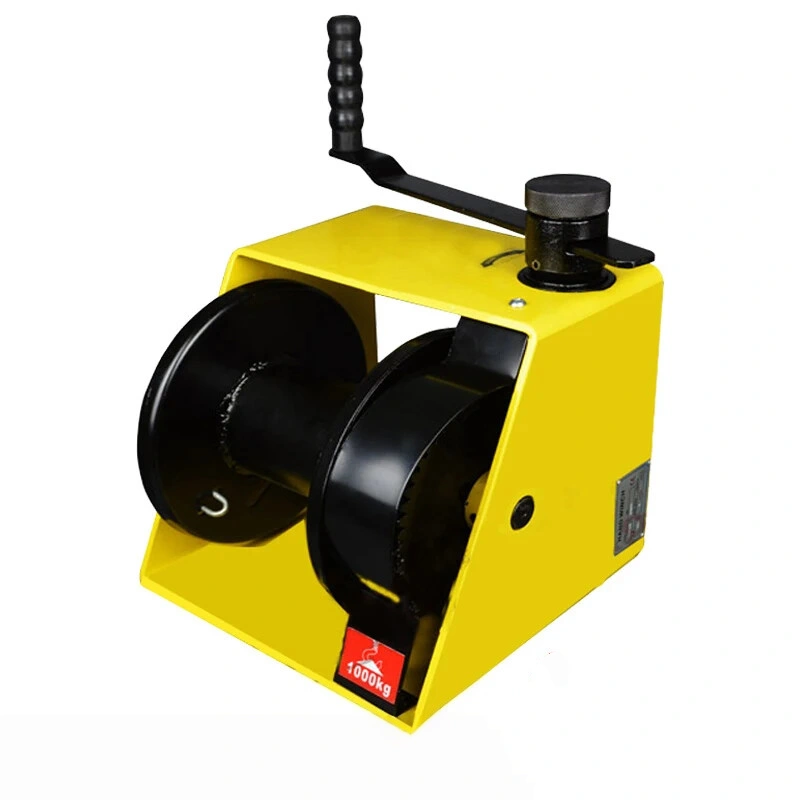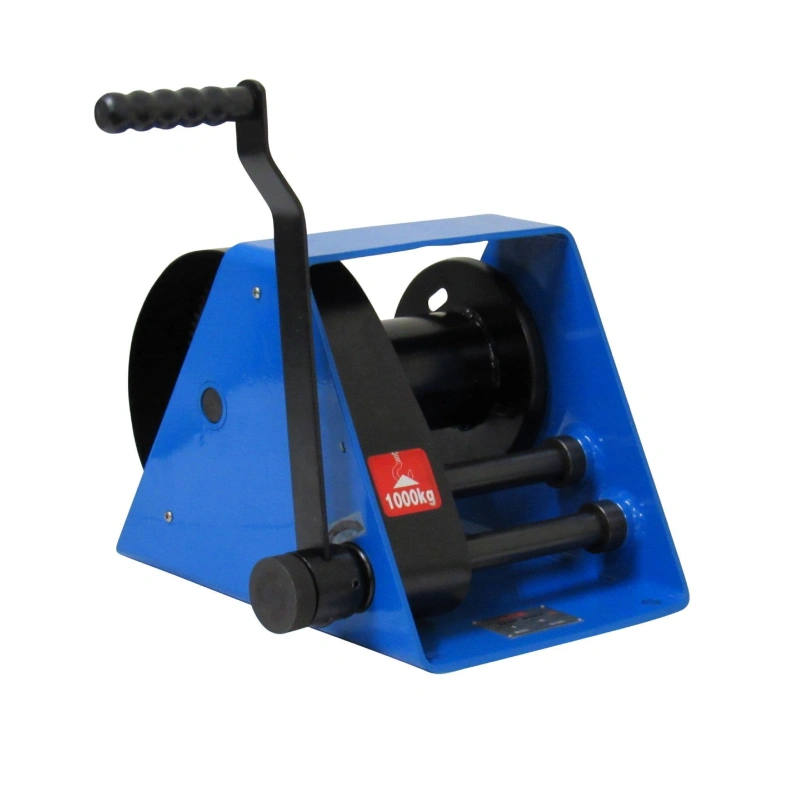You use a stud link chain when you need maximum strength for marine anchoring or heavy industrial tasks. Each link has a central stud, which gives the chain extra stability and prevents twisting. Studless chains offer more flexibility and lighter handling, but they do not match the strength of stud link chains.
Choosing the right chain protects your equipment and ensures safety. Powerful Machinery provides certified anchor chains trusted by professionals worldwide.
Key Takeaways
- Stud link chains provide maximum strength and stability, making them ideal for heavy-duty marine anchoring and industrial tasks.
- Regular inspection and maintenance of stud link chains enhances safety and extends their lifespan, ensuring reliable performance in harsh environments.
- Choosing the right anchor chain involves considering factors like chain grade, size, material, and environmental conditions to match your vessel’s needs.
- Studless chains offer flexibility and lighter handling, making them suitable for smaller vessels or applications where quick deployment is essential.
- Powerful Machinery provides certified stud links and studless chains, ensuring quality and compliance with international safety standards.
Stud Link Chain Basics
What is a Stud Link Chain?
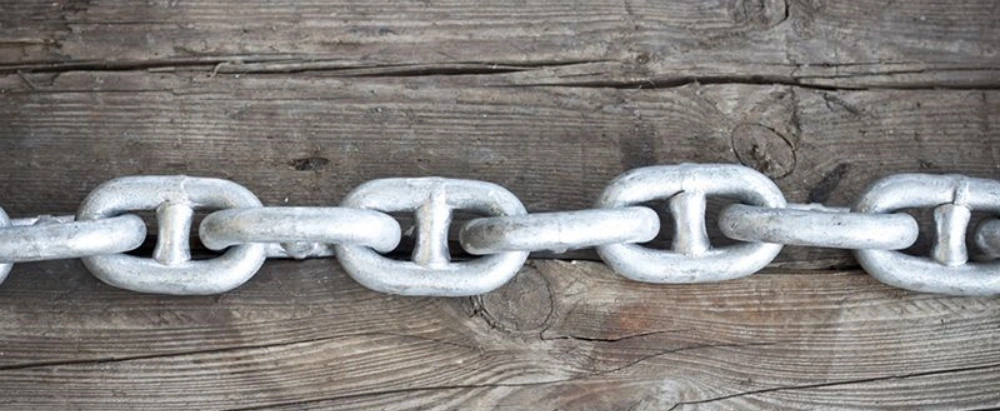
A stud link chain is a type of heavy-duty chain used mainly in marine and industrial settings. You will notice that each link has a solid bar, called a stud, running across its center. This stud gives the chain extra strength and keeps the links from deforming or twisting when under heavy loads.
The design also helps the chain stay flat and prevents it from tangling. When you use a stud link chain, you get a product that resists stretching and maintains its shape, even in tough conditions. The interconnected links and cross-shaped studs work together to provide structural integrity and reliable performance.
This makes the chain a trusted choice for anchoring ships, mooring, and other demanding applications.
Powerful Machinery specializes in manufacturing high-quality stud link chains. The company uses advanced production methods and strict quality control to ensure every chain meets international standards.
You can rely on their products for safety and durability, whether you need them for commercial shipping or offshore platforms.
Key Features
When you choose a stud link chain, you benefit from several important features that make it ideal for marine use. Here is a table that highlights the most common features:
| Feature | Description |
|---|---|
| Resistance to wear and tear | The stud link design helps to distribute the load evenly, reducing wear and tear on the chain. |
| Easy to inspect and maintain | The individual links can be easily inspected and replaced if damaged, reducing downtime. |
| Versatility | It can be used in various marine applications, including anchoring, mooring, and towing. |
| Material | Typically made from high-strength steel, such as alloy steel or stainless steel. |
| Link size and shape | Varies depending on the application and load requirements. |
| Stud design | It can vary, with some chains featuring a single stud and others featuring multiple studs. |
| Finish | It can be finished with coatings like galvanizing, paint, or epoxy for corrosion protection. |
| Certifications | Meets various certifications such as API, ABS, DNV, and IRS for quality and safety standards. |
You will find that the interlocking studs create a strong connection and prevent accidental detachment under high loads. The high tensile strength allows the chain to handle heavy tension without failing.
The studs welded on the links also prevent kinking and twisting, which is important for reliable performance in marine environments.
Tip: Regular inspection of your stud link chain helps you spot damage early and maintain safety on board.
Materials and Grades
Stud link chains come in different materials and grades to suit various needs. The most common material is hot-rolled anchor steel, which provides excellent strength and durability.
Some chains use stainless steel, such as 316 or 316L, for better corrosion resistance, especially in saltwater environments. You can also find chains made from low-carbon alloy steel, which is often used in higher-grade chains.
Here is a table showing the typical materials and finishes:
| Material Type | Description |
|---|---|
| Hot-rolled anchor steel | Main material used for stud link chains |
| Stainless steel 316/316L | Alternative material for corrosion resistance |
| Carbon steel | Commonly used for commercial shipping |
| Galvanized steel | Available in various grades and offers protection |
| Surface Treatment | Black asphalt coating, hot-dip galvanized finishes |
Stud link chains are available in different grades, such as Grade 2 and Grade 3. Higher grades mean higher strength and better performance. All sizes of Grade 3 chains are heat-treated and proof load tested to ensure they meet strict safety standards.
Powerful Machinery offers a wide range of certified stud link chains. Each chain undergoes rigorous testing and meets international certifications like ISO 1704. You can choose from different sizes, grades, and finishes to match your specific requirements.
Stud Link Chain Benefits
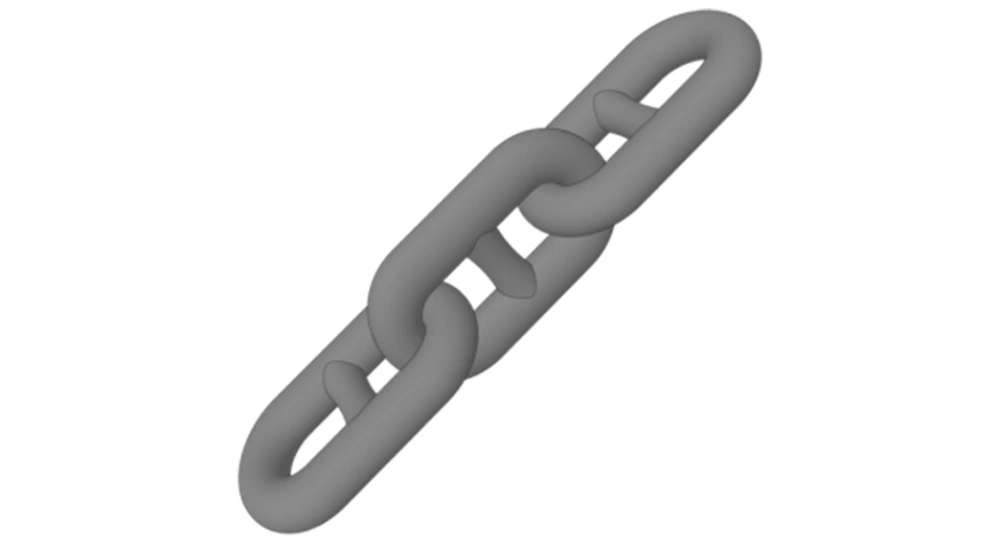
Strength and Stability
You rely on stud-link chains when you need the highest load-bearing capacity for marine projects. These chains stand out as the strongest type of anchor chain. You see them used on large ships that transport heavy loads across oceans. The central stud in each link prevents twisting and keeps the chain stable under pressure.
This design gives you confidence during marine anchoring and other demanding marine applications.
- Stud-link chains deliver unmatched strength for heavy-duty marine projects.
- You benefit from their ability to handle extreme loads without stretching or deforming.
- The chain’s structure ensures stability, even when exposed to rough seas.
Here is a table showing typical load-bearing capacity for stud-link chains:
| Chain Size | Proof Load (KN) | Breaking Load (KN) |
|---|---|---|
| 90mm | 4090 | 5840 |
You can find breaking loads ranging from 75,000 lbs to nearly 2,000,000 lbs, making stud-link chains essential for large marine applications.
Durability and Corrosion Resistance
Stud-link chains are built to last in harsh marine environments. You need chains that resist corrosion and wear, especially when working on marine projects. Powerful Machinery uses high-quality steel and advanced coatings to protect each chain. You get chains that withstand saltwater, abrasion, and constant movement.
Note: Regular maintenance extends the life of your stud-link chains and keeps your marine projects safe.
Here is a table showing how stud-link chains perform in different conditions:
| Environmental Condition | Description |
|---|---|
| Marine Environments | High tensile strength and resistance to wear keep your chain safe and stable. |
| Corrosion Resistance | Essential for durability in harsh marine conditions. |
| Strength and Durability | Critical for anchoring and mooring applications. |
You can trust stud-link chains to maintain their load-bearing capacity and integrity over time.
Stud Link Chain Uses
You use stud-link chains for many marine applications and industrial tasks. Their high load-bearing capacity makes them perfect for anchoring vessels and securing floating structures. You also see them in towing operations and lifting systems.
- Anchoring vessels in deep water
- Securing floating docks and offshore platforms
- Towing heavy equipment during marine projects
- Supporting various lifting systems in industrial settings
Stud-link chains contribute to operational safety. You get high tensile strength, flexibility, and corrosion resistance. These features help distribute forces, absorb shock loads, and protect against metal fatigue. You ensure stability and safety for every marine project.
Studless Chain Overview
What is a Studless Chain?
You see a studless chain used in marine environments where flexibility matters. This chain has links without a central stud, which makes it lighter and easier to handle. The absence of studs allows the chain to bend and adapt to the shape of the anchor and the seabed.
You often choose a studless anchor chain for smaller vessels or situations where you need quick deployment and retrieval.
Here is a table comparing the structure of studless chains and stud link chains:
| Feature | Stud Link Chain | Studless Chain |
|---|---|---|
| Crosspieces | Equipped with crosspieces | No crosspieces |
| Strength | Greater strength when the size/material is the same | Lower strength compared to the stud link chain |
| Deformation | Less deformation | More deformation |
| Twisting | Less prone to twisting when stacked | More prone to twisting |
| Usage | Widely used for large and medium-sized ships | Typically used for small ships |
Studless Chain Features
You benefit from several features when you use a studless anchor chain. The links interlock smoothly, which reduces snagging and ensures consistent strength. You get high tensile strength because manufacturers use high-grade steel. The chain distributes loads evenly, which lowers the risk of failure.
Protective coatings help resist corrosion, so you can use the chain in saltwater without worry. The flexibility lets the chain adapt to different anchor shapes and seabed contours.
Powerful Machinery offers studless anchor chains that meet ISO standards. You can choose custom lengths, materials like galvanized steel or AISI 316 stainless steel, and finishes such as hot-dip galvanization or painting.
The chains come with certifications from RINA and BV, which means you get reliable safety and performance.
Here is a table showing key features of studless anchor chains:
| Feature | Description |
|---|---|
| Construction | Interlocking links without studs, minimizing snagging |
| High Tensile Strength | Made from high-grade steel for heavy loads |
| Uniform Load Distribution | Even load distribution reduces risk of failure |
| Corrosion Resistance | Protective coatings enhance resistance to rust |
| Flexibility and Bending | Adapts to anchor shape and seabed |
| Certification and Standards | Meets ISO standards, certified by RINA and BV |
| Chain Accessories | Compatible with various anchor and handling equipment |
Tip: You can request custom lengths and finishes for your studless anchor chain to match your specific marine needs.
Studless Chain Applications
You use a studless anchor chain in many marine settings. Offshore drilling platforms rely on these chains for stability in deep water. Shipping companies use them to anchor and moor vessels, preventing drifting. Naval operations depend on studless anchor chains to secure ships in different locations.
Here is a table showing common applications:
| Application Area | Description |
|---|---|
| Offshore Drilling | Secures drilling platforms and floating rigs in deepwater locations |
| Shipping | Anchors and moors vessels, ensuring stability |
| Naval Operations | Secures naval vessels, providing holding power and stability |
You can trust Powerful Machinery’s studless anchor chain for reliable performance in harsh marine environments. The chain’s flexibility, corrosion resistance, and certification make it a smart choice for anchoring and mooring tasks. You also benefit from customization options, so your chain fits your vessel and project requirements.
Stud Link vs Studless Chain
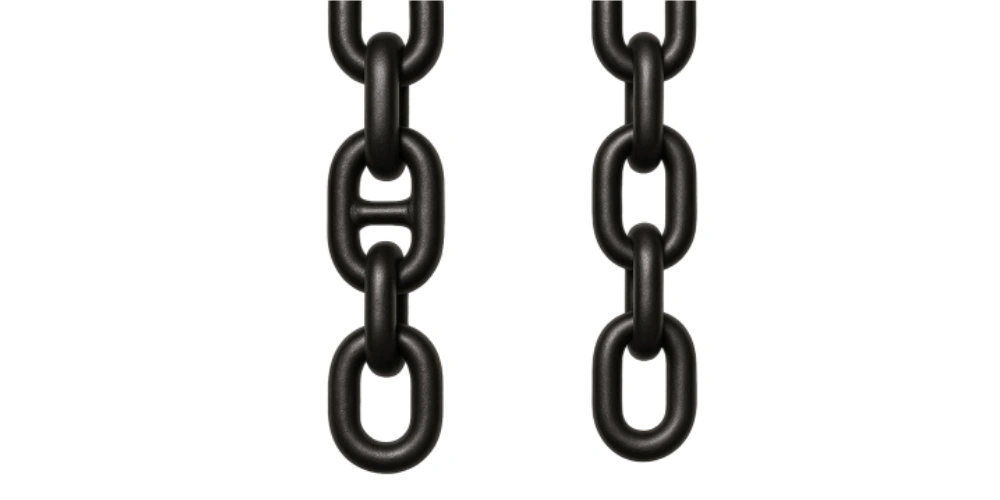
Design Differences
When you compare stud link and studless chains, you notice clear differences in their construction. Stud link chains have a solid bar, called a stud, running through the center of each link.
This stud increases the chain’s strength and keeps the links from twisting or deforming. Studless chains do not have this central stud. Their links are smooth and lighter, which makes them easier to handle.
Here is a table that shows the main design differences:
| Feature | Stud Link Anchor Chain | Studless Link Chain |
|---|---|---|
| Shape | Contains a stud in the middle of each link | No stud in the middle of each link |
| Purpose | Used in anchor systems for ships and boats | Used for boats, fender chains, and equipment with less pulling force |
| Proof Load and Breaking Load | Higher due to the stud, resulting in greater weight | Lower due to the absence of the stud |
| Weight | Heavier due to the stud | Lighter, offering weight savings |
You see stud link chains on large vessels and offshore platforms. Powerful Machinery’s stud link chain features a central stud for extra strength and stability. You use studless chains when you need flexibility and lighter handling, such as on smaller boats or for fender chains.
Powerful Machinery’s studless anchor chain is designed for easy handling and adapts well to different anchor shapes.
Performance Comparison
You choose between these chains based on your project’s needs. Stud link chains provide enhanced load-bearing capacity, which makes them ideal for high structural integrity applications.
You rely on them for anchoring large ships or securing offshore platforms. The central stud helps distribute force evenly and prevents twisting, so the chain stays stable under heavy loads.
Studless chains save weight and are easier to handle. You benefit from their flexibility, especially when you need to deploy or retrieve the chain quickly. The absence of the stud allows studless chains to deliver similar static strength and fatigue life while being about 9% lighter.
This weight reduction matters for floating platforms with long mooring lines. You can achieve cost savings in deepwater projects because lighter chains reduce the overall load on your equipment.
Here is an ordered list that highlights how design affects performance:
- Stud link chains work best when you need high structural integrity and maximum load-bearing capacity.
- Studless chains are preferable when you want weight savings and easier handling.
- Your choice depends on anchoring requirements and environmental conditions.
You also find that studless chains are easier to inspect and maintain. Their smooth links resist corrosion better, which helps in saltwater environments. Powerful Machinery offers both types, so you can select the chain that matches your vessel and project.
Cost and Value
You consider cost and value when selecting an anchor chain. Stud link chains cost more because of their robust design and higher material usage. You pay for extra strength and durability, which is essential for large ships and demanding marine operations.
Powerful Machinery’s stud link chain provides long-term value through its reliability and compliance with international standards.
Studless chains offer savings in both weight and price. You spend less on materials and transportation because the chain is lighter. This makes studless chains a smart choice for smaller vessels or projects where flexibility and ease of handling matter most.
Powerful Machinery’s studless anchor chain gives you certified quality and customization options, so you get the best value for your investment.
Tip: You should match the chain type to your vessel size and anchoring needs. This ensures safety and cost-effectiveness for your marine operations.
Choosing the Right Anchor Chain
Key Selection Criteria
You want to choose the right anchor chain for your vessel. Start by looking at several important criteria. The chain grade affects strength and corrosion resistance. Size depends on your vessel, anchor type, and water depth. Material matters because stainless steel resists corrosion in saltwater.
You also need to think about holding requirements, such as weather and seabed conditions. Always check that your chain meets maritime regulations for safety.
| Criteria | Description |
|---|---|
| Chain Grades | Different grades offer varying strength and corrosion resistance. |
| Size Determination | Vessel size, anchor type, and water depth influence chain size. |
| Material Considerations | Stainless steel provides high corrosion resistance. |
| Holding Requirements | Weather, currents, and seabed composition affect chain choice. |
| Regulatory Guidelines | Chains must comply with maritime safety standards. |
Tip: You can ask Powerful Machinery for help with chain selection. Their experts guide you through every step.
Stud Link Anchor Chain for Large Vessels
You need a stud link anchor chain when you operate a large vessel. This chain gives you maximum strength and stability. The central stud prevents twisting and keeps the chain flat. You see stud link anchor chains used on ships, offshore platforms, and commercial vessels.
Powerful Machinery offers chains in different sizes and grades to match your needs.
| Chain Size/mm | Material | Grade | Proof force/KN | Break force/KN |
|---|---|---|---|---|
| 14 | Carbon alloy steel | U2 | 82 | 116 |
| 28 | Carbon alloy steel | U2 | 321 | 449 |
| 50 | Carbon alloy steel | U2 | 981 | 1370 |
| 58 | Carbon alloy steel | U2 | 1300 | 1810 |
You get U2 grade stud link anchor chains for general marine use. U3 grade chains work best for demanding conditions. Powerful Machinery tests each stud link and anchor chain to meet ISO standards. You can trust their chains for safety and long service life.
Studless Chains for Flexible Applications
You choose studless chains when you need flexibility and easy handling. These chains work well for smaller vessels or lighter-duty anchoring. Studless chains weigh less and adapt to different anchor shapes. You benefit from their smooth links and corrosion resistance.
Powerful Machinery provides studless anchor chains with custom lengths and finishes. You get certified products that meet international standards.
- Stud link anchor chains suit high-strength applications.
- Studless chains fit lighter operations and save weight.
- Environmental factors and anchoring needs guide your choice.
Note: Powerful Machinery helps you select the right chain for your vessel and environment.
Conclusion
You now understand the key differences between stud link and studless chains. Stud link chains give you maximum strength and stability for large vessels. Studless chains offer flexibility and easy handling for lighter applications.
Always match your chain type to your vessel and environment to ensure safety and performance. For certified, high-quality anchor chain solutions, consult Powerful Machinery.
Choosing the right chain protects your crew and equipment.
FAQ
What is the main difference between stud link and studless chains?
You see a stud link chain with a central stud in each link. This design gives extra strength and prevents twisting. Studless chains have smooth links, making them lighter and easier to handle.
How do you choose the right anchor chain for your vessel?
You should check your vessel size, anchor type, and operating environment. Select the chain grade and material that match your needs. Powerful Machinery experts can help you make the best choice.
Can you use studless anchor chains in saltwater?
You can use studless anchor chains in saltwater. Chains made from galvanized steel or stainless steel resist corrosion. Powerful Machinery offers certified chains for marine environments.
How do you maintain your anchor chain for long life?
You should inspect your chain regularly for damage or rust. Wash it with fresh water after use. Apply rust inhibitors and store them in a dry place. Proper care extends the chain of life.

